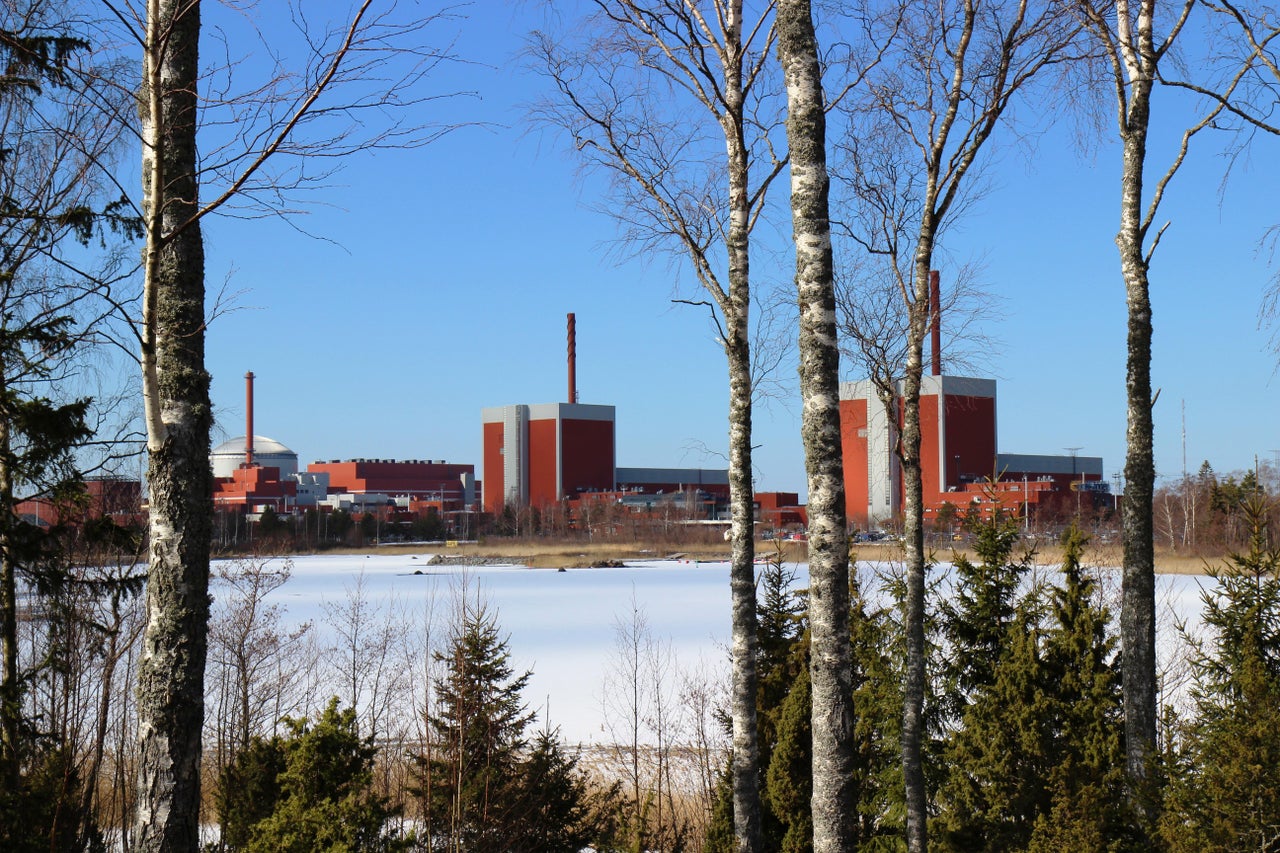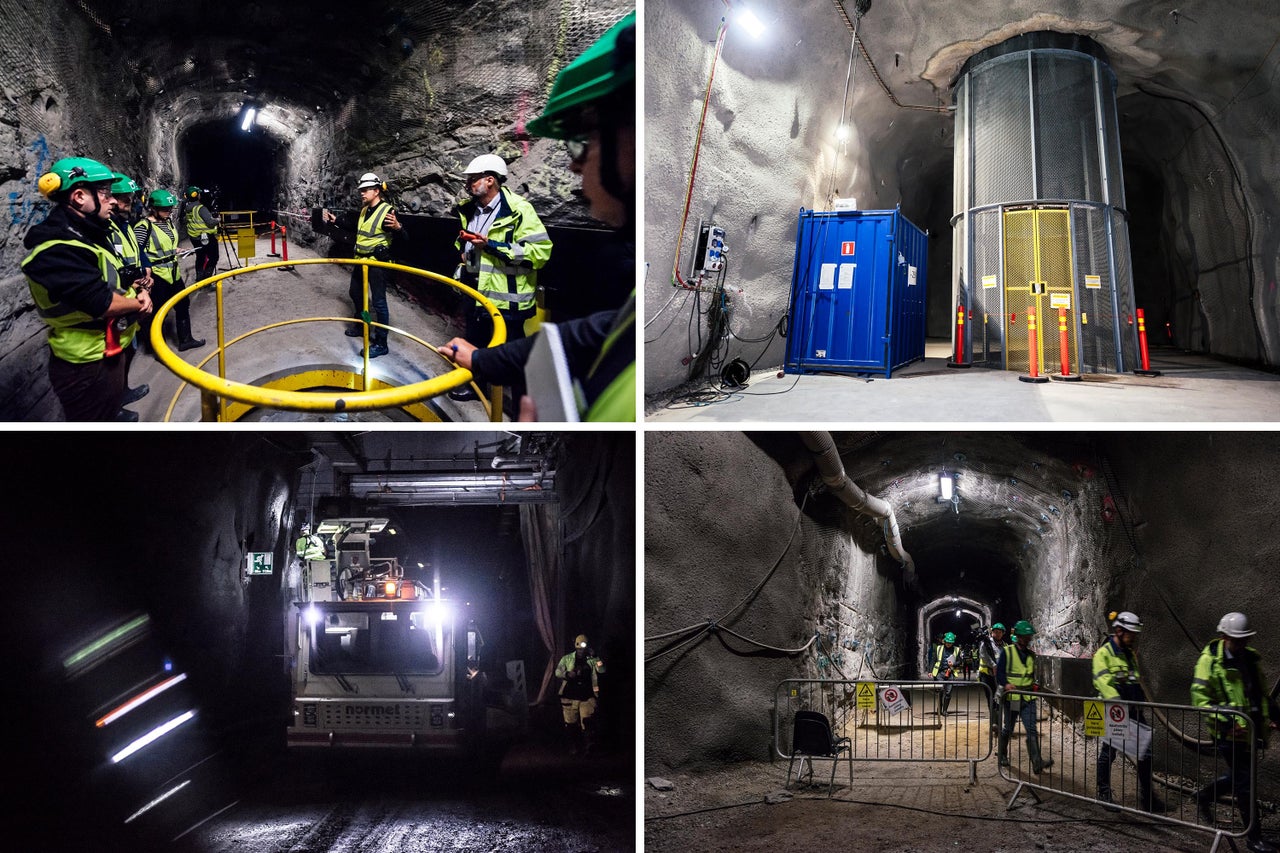OLKILUOTO ISLAND, Finland ― From the outside, it looks like any other modern Nordic building rising several stories from a cleared swath of pine forest on this quiet, rural island off this country’s verdant southwest coast.
But inside, hard-hatted workers are busy completing a feat of engineering that has never existed. It involves a robotic system and a basement network of switchbacking tunnels carved more than 1,300 feet into the Earth’s crust. Once finished, the project, called Onkalo, will turn the page to a new chapter of nuclear energy’s turbulent 80-year story and make history for the power plant just a two-minute drive down the road.
In a matter of months, the machines inside this boxy gray building will begin a weekly routine that will continue for a century: placing highly radioactive gray cuboid rods into copper cylinders the length of a Lincoln Town Car. From there, the canisters will travel roughly two hours underground to crypts meant to keep the spent-fuel rods undisturbed for millennia in bedrock that geologists say hasn’t shifted in almost 2 billion years. Sealed twice over in bentonite clay ― which expands when wet, preventing water from seeping in and corroding the capsules, and offers stability in case of an earthquake ― this site is meant to entomb nuclear waste for as close to eternity as any human endeavor can guarantee.
The project will store waste from the decades-old nuclear power complex next door. Last month, Finland switched on Olkiluoto-3, the third and biggest generator at the power station here. The reactor, one of the largest ever built and the first to open in Western Europe in at least 15 years, will produce about 14% of Finland’s electricity. Combined with the plant’s other two reactors, this speck of an island will provide 36% of the country’s power.
On its own, the new reactor would be notable as a rare bullish bet on atomic power at a time when, despite the world’s attempts to slash climate-changing emissions and wean Europe off the fossil fuels financing Russia’s war machine, more countries have closed nuclear plants than have opened new ones. But Onkalo makes this the world’s first nuclear power plant that solves the problem of the toxic waste that has for years rendered humanity’s most reliable and efficient energy source politically radioactive across much of the globe.

NurPhoto via Getty Images
“This is a message from Finland that we have a solution to make nuclear power sustainable,” said Janne Mokka, the chief executive of Posiva Oy, the company building the storage site. “This gives certainty on what is the question of final disposal. It has never been done.”
Yet it has been tried. The United States proposed building a permanent storage site in the Nevada desert at Yucca Mountain but canceled the project a decade later under pressure from Nevada politicians and Native Americans. France is digging its own facility, where it will store waste in clay. Sweden is working on an underground repository that mirrors Finland’s approach. Canada is also considering possible sites for its own.
Nuclear energy has remained controversial across the rich world, even though it’s one of the safest forms of electricity generation, especially compared with fossil fuels that not only cause climate change but also lace the air with deadly disease-causing particles. Reactors are by far the most reliable source of electricity in existence, producing tremendous volumes of power 24/7 from relatively tiny nuggets of mined uranium, unlike solar panels and wind turbines that require vast operations and huge amounts of metal, and can prove less reliable in cloudy, windless weather. But nuclear power has very high upfront costs and the building process is slow. It’s also politically unpopular, in no small part because of the threat posed by radioactive waste.
The United Nations’ International Atomic Energy Agency hailed Onkalo as a “game changer” for the nuclear industry when its officials toured the construction site in November 2020. Replicating the storage facility could prove tricky, particularly in the U.S., and some in the industry wonder if permanent burial is in fact the best answer to waste that still contains vast quantities of usable energy.
But Finland is hoping to show the world how to preserve our climate and modern industrial society for future generations without saddling them with waste that remains dangerous for as many years as have passed since mammoths and early humans roamed the Ice Age tundra.

Alexander C. Kaufman/HuffPost
Radioactive Reputation And U.S. Missteps
More than a quarter-million tons of nuclear waste sits stored at power plants across the world.
The U.S. alone has produced more than 85,000 metric tons of spent fuel since the 1950s. That may sound like a lot, but nuclear waste is heavy, and even that total is compact enough to fit on a single football field. Hardly the green glowing goo seen in cartoons, spent fuel comes out in hollow bundles of zirconium-alloy rods filled with gummy bear-sized pellets of enriched uranium. The country’s 93 remaining reactors, which generate just less than one-fifth of U.S. electricity, produce waste at a rate of about 2,000 tons per year. Spent fuel is stored across the country at about 80 sites, mostly at the same facilities as the reactors that produced the waste, either in container pools where rods are kept cool or in dry casks.
A typical large reactor produces about 25 metric tons of high-level radioactive spent fuel per year. Finland has five large reactors.
Nuclear reactors produce energy by splitting atoms of uranium in a process known as fission, where a neutron collides with an atom, splits it and releases huge volumes of energy in the form of heat and radiation. In a power plant, that heat is harnessed to turn water into steam, which spins turbines that generate electricity.
Radiation is all around us all the time. It’s just energy moving through space, and it takes many forms, including ultraviolet light and radio transmission signals. Its effect on human health is measured by a metric called sieverts. One millisievert ― one-thousandth of a sievert ― is harmless. A banana contains 0.01 millisieverts. Uranium miners and nuclear plant workers receive an average annual dose of about 2 millisieverts, according to the World Nuclear Association data. A flight crew routinely taking the polar route from New York City to Tokyo takes in about 9 millisieverts per year. A single pelvic CT scan generally equates to a 10 millisievert dose. After exposure to 100 millisieverts, your chances of getting cancer may go up slightly.

Antti Yrjonen/NurPhoto via Getty Images
A single dose of 1,000 millisieverts is enough to induce nausea, vomiting and hemorrhaging. At least half the people in a group exposed to 5,000 millisieverts at once will die within a month. A short-term dose of 10,000 millisieverts is a death sentence within weeks.
The average person receives 2.4 millisieverts per year from ambient radiation just from walking around, receiving low doses of radon and thoron in homes and buildings and from cosmic radiation. The average U.S. home exposes you to 228 times more radiation than living near a nuclear power plant, according to Environmental Protection Agency data.
A decade after it’s removed from a reactor, nuclear waste can produce a dose of radiation of about 100,000 millisieverts per hour. But radiation decreases in half-lives over time. After about 1,000 years, waste decays back to the radioactive levels of its original mined ore, but keeping it isolated from the environment around it remains important to avoid irradiating plants and animals in the food chain. Onkalo is being built to last 100,000 years.
Such timescales give any reasonable person pause.
But nuclear power occupies a uniquely fear-inducing place in popular culture, goaded by images that range from the recklessly buffoonish nuclear plant operator Homer Simpson on “The Simpsons” — as well as his misanthropic boss, Mr. Burns — and scenes of skin-blistering agony in HBO’s “Chernobyl.”
Ash from a coal-burning power plant, which contains radioactive materials and heavy metals such as cadmium and mercury that, unlike uranium, remain steadily toxic forever, spews 100 times more radiation into the surrounding area than a nuclear plant producing the same amount of energy. Radioactive minerals dredged up during gas drilling now contaminate communities across the U.S. The fine particles that burning fossil fuels spew into the air, meanwhile, caused 1 in 5 premature deaths worldwide in 2018 alone, according to a landmark Harvard University study, and increased the rates of diseases ranging from erectile dysfunction to dementia.
Just 49% of U.S. adults said they favor nuclear power in a 2019 Gallup poll, down from a high of 62% in 2010. Overwhelming majorities of self-identified Democrats, women and those without college degrees opposed nuclear power. More Republicans than Democrats supported expanding nuclear power in a Pew Research Center survey from January. A plurality of U.S. adults, 35%, favored encouraging production of nuclear power, while 26% wanted the energy source…
Read More:Finland Is On The Brink Of A Nuclear Power ‘Game Changer’
2022-04-23 11:00:03
